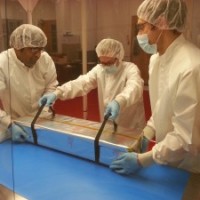Instrumentation

Overview
Penn State professor Suvrath Mahadevan led the development of the NEID spectrograph that is searching for low-mass planets around sun-like stars using the WIYN Telescope.
Penn State professors Suvrath Mahadevan and Larey Ramsey led the development of the Habitable Zone Planet Finder, a new instrument for the Hobby-Eberly Telescope that is enabling high-precision Doppler planet surveys using infrared light to target low mass stars.
Mahadevan also leads the NEID project a new high resolution planet-finding spectrograph that will be installed in 2019 on the 3.5-meter WIYN Telescope at Kitt Peak National Observatory near Tucson, Arizona.
Penn State is one of four partners in Project MINERVA, an observatory at Mt. Hopkins in Arizona that will make precise radial velocity measurements of bright nearby stars using a custom-built precise Doppler spectrograph, fed by four, small automated telescopes. CEHW astronomers are also developing methods using holographic diffusers to perform precise photometry capable of precisely measuring not only the transits of planets in front of their host stars, but the eclipse of hot planets as they pass behind their stars, using near-infrared wavelengths.
Faculty Contacts
- Suvrath Mahadevan is the PI for the Habitable Zone Planet Finder and NEID projects
- John Mathews
- Larry Ramsey led the development of a pathfinder IR spectrograph for the Hobby-Eberly telescope and now contributes to the Habitable Zone Planet Finder project.
- Jason Wright is one of four PI’s of project MINERVA, a new precise Doppler observatory being commissioned at Mt. Hopkins, that will use a novel stabilized iodine high resolutions spectrograph. He is also project scientist for the NEID spectrograph.




